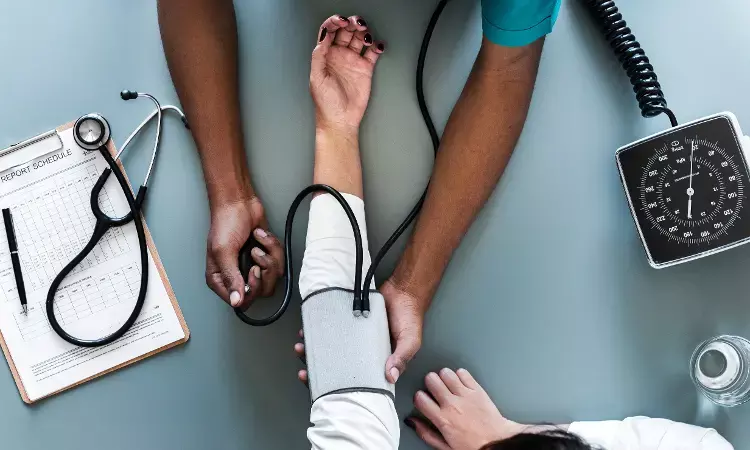- Home
- Medical news & Guidelines
- Anesthesiology
- Cardiology and CTVS
- Critical Care
- Dentistry
- Dermatology
- Diabetes and Endocrinology
- ENT
- Gastroenterology
- Medicine
- Nephrology
- Neurology
- Obstretics-Gynaecology
- Oncology
- Ophthalmology
- Orthopaedics
- Pediatrics-Neonatology
- Psychiatry
- Pulmonology
- Radiology
- Surgery
- Urology
- Laboratory Medicine
- Diet
- Nursing
- Paramedical
- Physiotherapy
- Health news
- Fact Check
- Bone Health Fact Check
- Brain Health Fact Check
- Cancer Related Fact Check
- Child Care Fact Check
- Dental and oral health fact check
- Diabetes and metabolic health fact check
- Diet and Nutrition Fact Check
- Eye and ENT Care Fact Check
- Fitness fact check
- Gut health fact check
- Heart health fact check
- Kidney health fact check
- Medical education fact check
- Men's health fact check
- Respiratory fact check
- Skin and hair care fact check
- Vaccine and Immunization fact check
- Women's health fact check
- AYUSH
- State News
- Andaman and Nicobar Islands
- Andhra Pradesh
- Arunachal Pradesh
- Assam
- Bihar
- Chandigarh
- Chattisgarh
- Dadra and Nagar Haveli
- Daman and Diu
- Delhi
- Goa
- Gujarat
- Haryana
- Himachal Pradesh
- Jammu & Kashmir
- Jharkhand
- Karnataka
- Kerala
- Ladakh
- Lakshadweep
- Madhya Pradesh
- Maharashtra
- Manipur
- Meghalaya
- Mizoram
- Nagaland
- Odisha
- Puducherry
- Punjab
- Rajasthan
- Sikkim
- Tamil Nadu
- Telangana
- Tripura
- Uttar Pradesh
- Uttrakhand
- West Bengal
- Medical Education
- Industry
Breakthrough: Robots that can check your blood pressure

Empowering small, humanoid-sensing robots to take a patient's blood pressure-using only a simple touch-is Simon Fraser University researcher Woo Soo Kim's latest health care technology development.
Based on the intricacies of origami—and inspired by the movements of nature's leeches—his research is advancing how robots could carry out basic health care tasks in certain conditions, including in remote regions, or where minimal personal contact is needed, such as during pandemics. The research is published in the journal npj Flexible Electronics from Nature Publishing Group.
Together with PhD student Tae-Ho Kim and a team in SFU's Additive Manufacturing Lab, Kim and researchers have replaced the traditional blood pressure procedure by replicated the folding mechanisms of the leech in their design of 3-D printable origami sensors. The leech-inspired origami (LIO) sensors can be integrated onto the fingertips of a humanoid-sensing robot.
"Our origami-inspired dry electrode has unique characteristics such as suction for grasping and foldability inspired by nature," says Kim, a professor and associate director of SFU's School of Mechatronic Systems Engineering. "In keeping with nature, we saw that in addition to the complex mechanisms of a leech's adhesive feature, these creatures have an expandable posterior sucker and body, while its organs expand and shrink appropriately to maintain better adhesion to its victim. Incorporating this point of view, we found that origami can achieve similar motions and also be customized."
HOW IT WORKS
The LIO sensors integrated onto the robot's fingertips can be positioned on the patient's chest. Blood pressure is monitored and estimated by combining data from electrocardiogram (ECG)and photoplethysmogram (PPG) readings, as recorded by sensors on the fingers of each hand respectively.
Using predetermined algorithms, the signals from the paired sensors can generate a patient's systolic and diastolic blood pressure without using the traditional cuff-based digital sphygmomanometer.
Kim's earlier work involved programming sensing robots to measure other human physiological signals, such as those from an electrocardiogram (which monitors heart rate), temperature and respiration rate.
"Robotics offers a promising method to mitigate risk and improve patient care effectiveness and quality as focused remote healthcare technology," says Kim. The researchers plan further trials of their new process and are developing the next generation of sensors, which they hope will lead to its biomedically meaningful implementation.
"Blood pressure monitoring is an essential medical diagnostic tool for many chronic diseases and overall good health. The use of sensing robots in medical healthcare systems has substantial advantages because they can assist health care workers in monitoring patient vital signs while creating a friendly environment for those patients who may need to be isolated."
Kim believes that robotics can provide a future platform or bridge between medical personnel and remote patients with "the potential to play an essential role in the new era of remote healthcare."
The research is partially supported by a Discovery and Accelerator Supplement Grant, funded by the Natural Sciences and Research Council of Canada (NSERC).
http://dx.doi.org/10.1038/s41528-022-00139-x
Hina Zahid Joined Medical Dialogue in 2017 with a passion to work as a Reporter. She coordinates with various national and international journals and association and covers all the stories related to Medical guidelines, Medical Journals, rare medical surgeries as well as all the updates in the medical field. Email: editorial@medicaldialogues.in. Contact no. 011-43720751
Dr Kamal Kant Kohli-MBBS, DTCD- a chest specialist with more than 30 years of practice and a flair for writing clinical articles, Dr Kamal Kant Kohli joined Medical Dialogues as a Chief Editor of Medical News. Besides writing articles, as an editor, he proofreads and verifies all the medical content published on Medical Dialogues including those coming from journals, studies,medical conferences,guidelines etc. Email: drkohli@medicaldialogues.in. Contact no. 011-43720751


